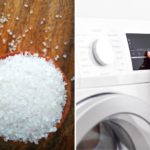All washers are subject to a classic case of wear and tear and it’s safe to say that most of us will be able to easily bring to mind the sound of a washing machine that’s on its last legs.
Bearings are an essential part of your washing machine as they work to ensure that the drum is spinning correctly. The demise of your bearings is usually caused by rust, which will worsen over time as water seeps through the seals around the metal bearings.
If you open the back panel of your washing machine and can spot rust in the areas around the motor, it’s a sure sign that your bearings have gone or are on their way out.
If you find yourself in this situation, you may be wondering, can you continue to use a washing machine when the bearings have gone, and is it safe?
Technically it is possible to continue to use a washing machine after the bearings have gone. However, doing so can damage the other parts of your machine, which will make it dangerous to use. It’s safer and more cost effective to replace bad bearings sooner rather than later.
How to Tell If Your Washing Machine’s Bearings Have Gone
There are a few pretty obvious ways to figure out if your bearings are starting to go. The first will be that the sound emanating from the machine will start to resemble an avalanche rolling swiftly down the side of Mount Everest.
The other clue would be if you were to take a peek into the drum while it’s on a wash and see that the inner drum is moving up and down separately from the fixed outer drum. It’s quite likely that your bearings are worn if that inner drum is moving by more than a couple of millimetres.

How to Keep a Washing Machine with Damaged Bearings Running
If you aren’t quite ready to take the leap and invest in a brand-new washing machine, then there are a few ways to keep your machine running a little longer, even with the bearings giving you trouble.
Grease them
The bearings are not the most easily accessible part of your washing machine, but once you do get to them, it’s easy enough to grease them.
All you have to do is remove them from the machine, take off the protective cover and the oil seal and then use an approved lubricant to grease the bearings.
Replace them
Replacing your bearings can often be the most economical solution. It will usually cost between £100-£200 to change the drum bearings and can be done yourself or by a professional.
Keep in mind some machines have outer sealed drums, meaning you can’t physically change the bearings. This will mean that replacing the entire machine is going to be your only option.
Repair them
Attempting to repair the bearings yourself is a great way to save money. There are boundless online tutorials such as this one, as well as YouTube videos.
If you feel that this task may be a little too much of a challenge, you can easily hire a professional to come in and do it for you.
If All Else Fails, Replace the Entire Machine
It’s possible to continue to use your machine to an extent, even when it becomes clear that your bearings are starting to wear.
This will, however, mean that the wear and tear that is already taking place will be dramatically accelerated. If you continue to use the machine without replacing or repairing the bearings, it will eventually break completely.
Depending on how old your machine is, it will often make more sense to replace the whole thing, as then you’ll have a reliable warranty, and you won’t have to worry about it breaking down on you again for a few more years!
Plus, you’ll have the peace and serenity of a washing machine that has a quiet whirr instead of the sound of a rocket ship exiting earth’s gravity.
See our roundup of the best washing machines in the UK here.

An adventurous book lover with an animal obsession and a proclivity for travel and spontaneity. Used to passionately despise cleaning but has grown to enjoy it thanks to learning all the best tricks and shortcuts to guaranteeing a stress-free routine and a spotless home.






